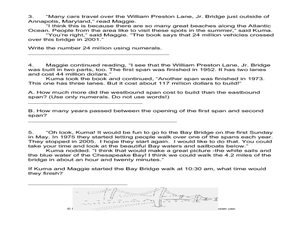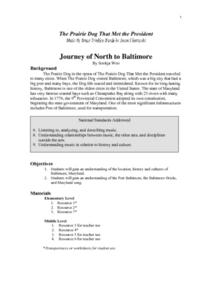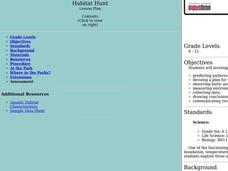Curated OER
What Happened To The Chesapeake Bay Filtering System?
In this Chesapeake Bay instructional activity, students read a dialogue between 2 people about what had happened to the Chesapeake Bay filtering system, and answer short answer questions about it. Students complete 4 questions.
Curated OER
Expand Your Math By Traveling Over the Chesapeake Bay!
In this Chesapeake Bay worksheet, students read word problems and answer questions about years passed, and money spent on the two ways to drive over Chesapeake Bay. Students complete 5 problems.
Curated OER
Victory at Yorktown
In this Yorktown victory historical term worksheet, students complete ten fill in the blank questions to assess their understanding of this time in United States history.
Curated OER
Social Studies: Maryland and Its Culture
Students discuss the history and culture of Baltimore, Maryland. they discover the importance of the city's port along with the state bird and song. Background sources include "The Prairie Dog That Met the President" and "Journey of...
Curated OER
Animals and Habitats of the Chesapeake Bay
Young scholars work in small groups to discover the various habitats present in Chesapeake Bay and the animals that live in them. After investigating the habits and lives of the animals they will draw conclusions about other habitats...
Curated OER
Native vs. Non-native Species: Who Will Win?
Students examine non-native species and the problems they have caused in the waters of the Chesapeake Bay. They create a "Wanted" poster for one of the species. They describe the effects of non-native species on the schoolyard species.
Curated OER
Journey of a Raindrop to the Chesapeake Bay
Young scholars explore the water cycle and the path a single drop of water would take if it traveled from their schoolyard to the Chesapeake Bay in Virginia.
Curated OER
Bay B C's
In this unit of lessons, students examine the Chesapeake Bay area. Students learn what lives here and how humans are affecting the area.
Curated OER
Jamestown
Fifth graders research the Jamestown settlement and examine life in the colonies from 1607-1610. They explore websites, develop a timeline, select two settlers to research, and write three letters written from the point of view of their...
Curated OER
Marine Debris on the Chesapeake Bay
Learners examine problem of litter and marine debris on the Chesapeake Bay, and experiment with density of marine debris.
Curated OER
Marsh March
Students investigate natural organization of a wetland and the interrelationships between the wetland and the surrounding environment.
Curated OER
Who Killed SAV?
Learners research the factors that contributed to the decline of submerged aquatic vegetation in the Chesapeake Bay. Students evaluate the natural and human factors that led to the decline of bay grasses.
Curated OER
Captain John Smith's Chesapeake Bay
Young scholars conduct research to determine how the Chesapeake Bay has changed since the 17th century when Captain John Smith first explored it. Students read from Smith's historical documents.
Curated OER
Captain John Smith's Chesapeake Bay
Fifth graders explore Captain John Smith and compare today's Chesapeake Bay to the one in the early 17th century.
Curated OER
C. B. Atlas Animations: Temperature Experiments
Students investigate cooling rates of shallow and deep water, analyze Chesapeake Bay temperature information, and interpret effects of temperature variations on living organisms.

















